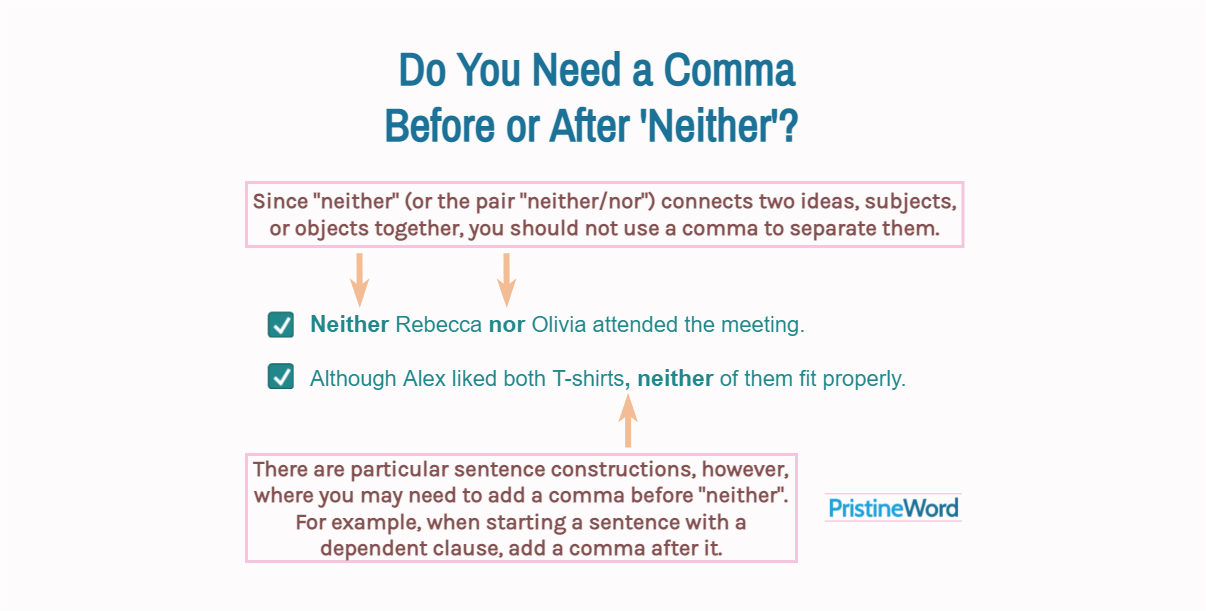Since "neither" (or the pair "neither/nor") connects two ideas, subjects, or objects together, you should not use a comma to separate them.
Since "neither" (or the pair "neither/nor") connects two ideas, subjects, or objects together, you should not use a comma to separate them.
Neither Rebecca nor Olivia attended the meeting.
Neither Rebecca, nor Olivia attended the meeting.
There are particular sentence constructions, however, where you may need to add a comma before "neither". For example, when starting a sentence with a dependent clause, add a comma after it.
Although Alex liked both T-shirts, neither of them fit properly.
Although Alex liked both T-shirts neither of them fit properly.
Contents
1. A Comma Is Generally Necessary Before 'Neither'
"Neither" can be a conjunction, a determiner, or a pronoun.
1.1 Neither/Nor (correlative conjunction)
As a correlative conjunction, the pair neither/nor links two negative statements of equal weight. This sentence structure is quite formal.
We do not typically place a comma before or after a correlative conjunction, such as neither/nor.
Neither Robert nor Olivia understood what was happening.
More examples
- Is Mary Swiss or Austrian? Actually, she is neither Swiss nor Austrian.
- Do you eat meat or eggs? Sorry, I eat neither meat nor eggs.
- I can buy neither the yellow car nor the white car.
1.2 Neither + singular noun (determiner)
As a determiner, we use "neither" before a singular noun to mean "not either one". We must not place a comma after "neither" in this situation.
Can we have our next lesson on the 11th or the 12th? Neither day is convenient.
More examples
- Neither engineer could solve the problem.
- I think that neither country has met all targets.
- Neither player can activate monster effects.
1.3 Pronoun
When functioning as a pronoun, we do not commonly place a comma before or after "neither".
Do you prefer to play football or basketball? Neither.
More examples
- Will you go by bus or by train? Neither.
- Which dress do you want? Neither!
- Are you going to France or Italy? Neither.
1.4 Neither of
We frequently use the following structures in English:
- "Neither of + plural pronoun"
- "Neither of + determiner + plural noun"
We must not place a comma after "neither" when using the combination "neither of + them/theirs/us/ours".
Has either of them called? Neither of them has called.
Follow the same strategy when using a determiner (my, your, his, the, these, those, etc.) followed by a plural noun after "neither".
Neither of these arguments are convincing.
More examples
- Neither of them is my friend.
- Neither of your pictures looks good.
- You can wear neither of my shirts.
1.5 Agreeing with a negative statement
Similarly, we do not generally use a comma before or after "neither" to agree with a negative statement.
I didn't sleep all night. Neither did I.
More examples
- I can't speak Thai. Neither can I.
- I am not tall. Neither is she.
- My husband cannot attend the meeting. Neither can Robert.
2. Exceptions
There are particular situations where commas may be required. For example, when starting a sentence with a dependent clause, add a comma after it:
Although Mary liked both skirts, neither of them fit properly.
Although Mary liked both skirts neither of them fit properly.
We also add a comma after an introductory phrase or word.
In my opinion, neither player should be kept out too long.
Actually, neither of them are nice.

